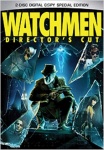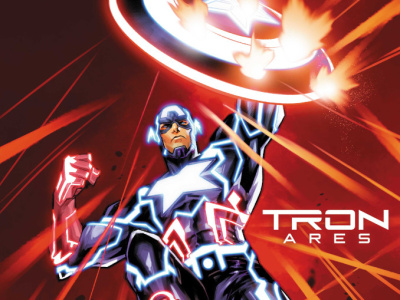
Title: Watchmen Director’s Cut DVD
Publisher: Warner Home Video
Creators: Zack Snyder (Director)
Publishing Date: July 21st 2009
Price: $34.98
Run Time: 3 Hours 6 minutes
Format: Anamorphic Widescreen, 2-Discs
Age Rating: “R”
ICv2 Rating: 4 Stars (Out of 5)
On
Adapting the un-filmable Watchmen with its multi-faceted graphic narrative techniques (which range from graphitti, to posters, to comics, to comics-within-comics, to prose magazine articles, and fragments from novels and journals), its host of “major” characters spanning two generations, and its complex interwoven plot structure with more flashbacks than Passage to Marseille, is a thankless task, but with the Director’s Cut edition of Watchmen, which includes 24 minutes of additional footage, Snyder has come as close to succeeding as anyone could have ever thought possible. Because it has by far the most interesting and compelling story of any superhero project attempted so far, and because Snyder managed to get most of that story up on the screen, this movie will likely gain in stature over the years as most of the spandex epics of our era fade into well-deserved obscurity.
The extras on the Watchman Director’s Cut DVD include the excellent documentary, “The Phenomenon That Changed Comics” as well as all 11 “Watchmen Video Journals” that seem to run about three minutes a piece, but diehard Watchmen fans are going to have to wait for the “full Monty.” According to Snyder (see “Later, Black Freighter”) there will be an additional “Black Freighter” cut of Watchmen, which will include the 21 minute Tales of the Black Freighter animated footage that will be cut into the live action flow of the story in much the same way that the Black Freighter metacomic was employed in the original graphic novel. The extras on this 5-disc Watchmen Ultimate Collector’s Edition, which is advertised on a flyer included with the Director’s Cut, will include “Under the Hood,” an innovative faux TV documentary that provides insights into the characters and historical background much like the prose excerpts in the original Watchmen comics (see “Watchmen: Tales of the Black Freighter Review”). Until the Ultimate Collectors Edition is released for the upcoming holidays, fans will have to content themselves with the Director’s Cut, which happens to be an improvement over the theatrical release, though it is clearly not the definitive version.
Snyder and his screenwriting crew of David Hayter and Alex Tse made other changes as well, most notably in the character of the Deus ex machina event that rescues the world from all-out nuclear conflict. In place of the graphic novel’s giant alien squid, which is an affectionate nod to the giant monster movies of the 1950s, the movie adaptation features a fusion-type reactor created by Doctor Manhattan in collaboration with Adrian Veidt in a last ditch attempt to save the world by offering a source of cheap non-polluting energy to all nations. It’s an elegant solution that is in many ways more suitable to the rest of the Watchmen saga, which is rooted in a harder sort of science fiction than that employed in 1950s SF movies. But it does weaken the “only way to unite mankind is with an alien invasion” trope that is alluded to in both the graphic novel and the movie with allusions to The Day the Earth Stood Still and the Outer Limits episode “The Architects of Fear.”
Less successful are the movie’s attempts to amp up the violence in the graphic novel. Filmed violence has more impact than what is presented on the typical comic book page, so in such a basically literal translation of a work like Watchmen, there is little need to pump up the bloodletting except to pander to those whose bloodlust can only be satisfied by a “hard R.” For example, during the attempted assassination of Adrian Veidt, Snyder shows Veidt's assistant being first shot through the leg with entry and exit wounds and full blood splatter and then shot in the chest, whereas in the graphic novel she is shot in the chest. The movie also adds a headshot of Lee Iacocca to the scene, another bit that was not in the graphic novel. In the sequence in which Rorschach is menaced in his cell, the fat guy that Rorschach traps has his throat slit off-panel (though with a major visible blood spurt), whereas in the movie his arms are chopped off with a circular saw in a sequence that would have fit right in any of the modern torture-themed horror movies, which rely on the cheap thrills of dismemberment. The most successfully executed sequence in the entire Rorschach prison breakout is the murder of Big Figure in the Men’s Room, which is depicted indirectly (as it is in the graphic novel) with blood oozing out from under the bathroom door.
While the mega slugfests between lumbering behemoths that have become among the most boring elements in the current wave of superhero films are mercifully absent in Watchmen, the struggle that results in the death of The Comedian is overblown in a Leone-esque manner that sets the operatic tone of much of the violence that is to come in the film. Only parts of the scene were depicted in the graphic novel, because to detail the actual fight might actually give away the attacker, who had certain advantages over his burly victim. Snyder cheats a little here, but he can be forgiven his attempts to make the film “more commercial.” Given the studio pressures that inevitably accompany a $135 million production, Snyder’s achievement in creating a film adaptation of Watchmen that is as good as this one is considerable—and The Director’s Cut is definitely the best way to admire it, at least until the Watchmen Ultimate Collector’s Edition release in the fourth quarter.
Speaking of Ultimate Editions, 300: The Complete Experience Blu-ray (MSRP $39.95) certainly qualifies as that. Not only does it provide a superb Blu-ray transfer, it comes with a 40-page full color book packed with great behind-the-scenes information and directions on how to use 300: A Comprehensive Immersion, a complex, but surprisingly easy to use (for those who have picture-in-picture capable Blu-ray players) way to watch the film on one of three different “paths.” “Path One” concentrates on Frank Miller’s creation of the original 300 graphic novel and Zack Snyder’s care in creating a stylized adaptation that remained true to both the visual and narrative elements of Miller’s vision. “Path Two” details the filmmaking techniques, both traditional and cutting edge used to create the movie, while “Path Three” compares the historical events of
Clearly 300: The Complete Experience is designed for those who are familiar with the film and want to enjoy it again in a new way and it delivers the goods. If studios are going to “double dip” with DVD releases, this is the way they should do with a deluxe package that delivers more than just a digital copy (which is included) and a host of conventional extras.
Watching the two films in close proximity it is interesting to compare the way in which Snyder keyed off Frank Miller’s art in 300 to create with the aid of green screen technology a stylized film with a very “graphic” look, while in adapting Dave Gibbons’ more realistic Watchmen art Snyder took a more conventional filmmaking approach using highly detailed sets. His ability to adapt his style to the material at hand and his penchant for selecting the most challenging and interesting graphic novel-based material available mark Snyder as the top director to emerge from the still nascent comic book genre.








